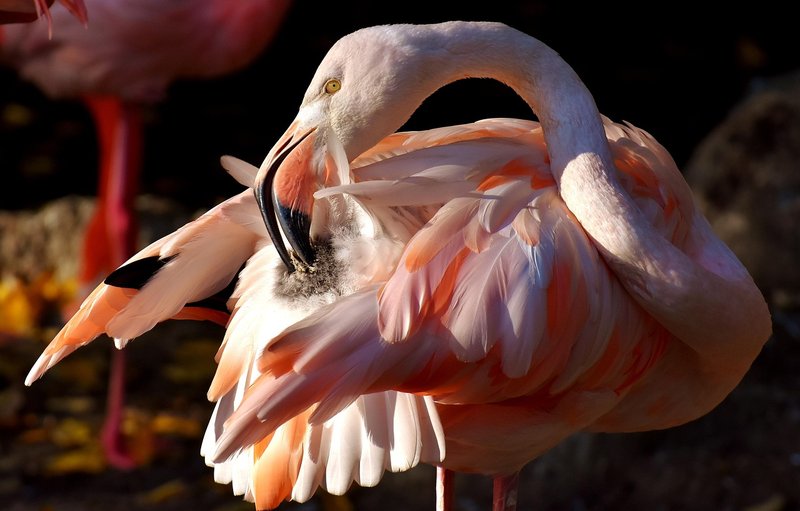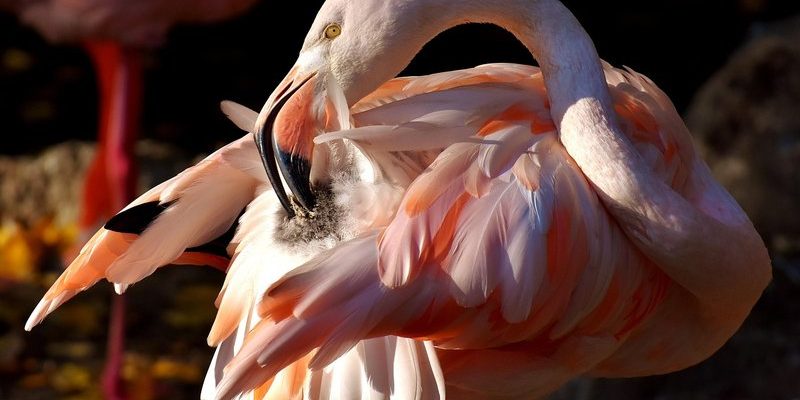
Honestly, flamingos have a fascinating world of quirks and traits that might surprise you. From their unique feeding habits to their social behavior, these birds tell an intricate story of adaptation and survival. So grab your favorite beverage and let’s dive into some lesser-known facts about flamingos!
1. They Get Their Color from Their Food
You might be wondering why flamingos are such a brilliant shade of pink. Here’s the thing: it all comes down to their diet. These lovely birds primarily eat shrimp and algae, both of which are rich in a pigment called carotenoid. It’s the same nutrient found in carrots, which gives them their orange hue. When flamingos consume these foods, their bodies process the carotenoids, and voilà! Their feathers transform from a dull gray to that vibrant pink we all admire.
If flamingos don’t eat enough of these carotenoid-rich foods, their feathers may fade to a lighter shade or even turn white. So, next time you see a flamingo, know that its color is a reflection of its diet! Imagine if we turned a different color based on what we ate—talk about a dinner conversation starter!
2. They’re Social Creatures
Flamingos are not just beautiful; they’re also highly social birds. You won’t find a solitary flamingo hanging out all alone; these birds thrive in large colonies that can include thousands of individuals. It’s like a giant social club! They gather in groups primarily for breeding, but they also stick together for safety and feeding.
When they’re in these large groups, flamingos perform synchronized movements, which can look like a carefully choreographed dance. This behavior helps strengthen social bonds and establishes a sense of community. So, if you ever see a flock of flamingos gracefully moving together, remember, they’re not just showing off their beauty—they’re also reinforcing their social ties.
3. Their Unique Feeding Technique
Feeding is another area where flamingos show off their unique adaptations. They have specialized beaks that allow them to filter-feed in shallow waters. Unlike most birds that eat by pecking at food, flamingos turn their heads upside down and sweep their beaks through the mud and water.
Here’s a fun fact: their beaks are uniquely curved, allowing them to filter out small organisms like shrimp and algae from the water. It’s almost like using a specialized tool for a job. Imagine trying to eat soup with a fork! It wouldn’t work very well, right? But for flamingos, this technique is perfectly adapted for their environment.
4. Flamingo Courtship Displays
When it comes to love, flamingos don’t just do the usual. Their courtship rituals are quite a spectacle! Mating begins with elaborate displays that can include head-flagging, bill clapping, and even synchronized marching. It’s like a romantic dance party, and all the singles in the flock are invited!
Once a pair has formed a bond, they usually stick together. Flamingos are monogamous, meaning they often mate with the same partner for life. Isn’t that kind of sweet? They build their nests out of mud in order to protect their eggs from predators, showing just how committed they are to each other and their future little flamingos.
5. Flamingos Have a Long Lifespan
Many people don’t realize that flamingos can live for a surprisingly long time. In the wild, they can live to be around 20 to 30 years old, and in captivity, some have been known to live even longer—up to 50 years! That’s quite a lifespan for a bird, isn’t it?
Their longevity comes from a combination of their social structure and their adaptability. Being in a group helps protect them from predators, and their specialized feeding habits ensure they get the nutrients they need. So, the next time you see a flamingo, think of it as not just a pretty face but a resilient survivor.
6. They Can Stand on One Leg for Hours
You might have seen flamingos standing on one leg and thought, “How do they do that?” Well, it’s not just for show; there’s a practical reason behind it. Standing on one leg helps them conserve body heat. Since they often live in warm tropical climates, this behavior allows them to keep one leg warm while resting the other. It’s a clever way to adapt to their environment!
Additionally, this stance also gives them a better vantage point to look out for predators. It’s like a built-in safety feature! Imagine if we could take a break while standing on one leg—it would be quite a workout for our balance!
7. Flamingos Have Different Species
Did you know that there are six different species of flamingos? Yes, they come in a variety of shapes and sizes! The most well-known species include the Greater Flamingo, which is the largest, and the Lesser Flamingo, which is smaller and often found in Africa and parts of Asia.
Each species has its own unique traits and habitat preferences. For instance, the Caribbean flamingo has a more vibrant coloration compared to others, while the Andean flamingo is adapted to high-altitude living. It’s incredible to think about the diversity within this group of birds, all of which have adapted to their specific environments over time.
8. Flamingo Breeding Habits
Breeding season is a busy time for flamingos. They usually nest in large colonies to provide safety against predators. Flamingos build nests out of mud that elevates their eggs above water levels. These mud mounds can be quite intricate and vary in height.
Once the eggs are laid, both parents take turns incubating them, which is a pretty cooperative effort. After about 28 to 32 days, the chicks hatch and are covered in gray down feathers. It’s fascinating to see how even at a young age, they start forming into the beautiful birds they will become.
9. They Are Found in Unique Habitats
Flamingos are quite adaptable and can thrive in various environments, but they prefer shallow waters that are rich in food sources. You’ll typically find them in lagoons, estuaries, and salt flats. These areas provide them with the right conditions to filter-feed effectively.
Additionally, flamingos can handle saline conditions, which is why they’re often found in saltwater lakes and coastal regions. Their ability to thrive in these somewhat harsh environments is a testament to their adaptability and resourcefulness.
10. Cultural Significance of Flamingos
Flamingos aren’t just fascinating because of their biology; they also hold significant cultural value in many societies. For example, in some Indigenous cultures of South America, flamingos symbolize beauty and grace. They’ve also become a popular icon in modern culture, appearing in fashion, art, and even lawn ornaments.
Their striking appearance and unique behaviors have made them subjects of fascination and admiration throughout history. Whether featured in art or simply enjoyed at a zoo, flamingos capture the hearts of many and inspire creativity.
In conclusion, flamingos are truly captivating creatures that offer a lot more than just a pretty picture. From their unique feeding habits to their vibrant social lives, these birds have a lot to teach us about adaptation and survival. Next time you spot a flamingo, take a moment to appreciate not just its beauty, but the incredible story behind its existence.

